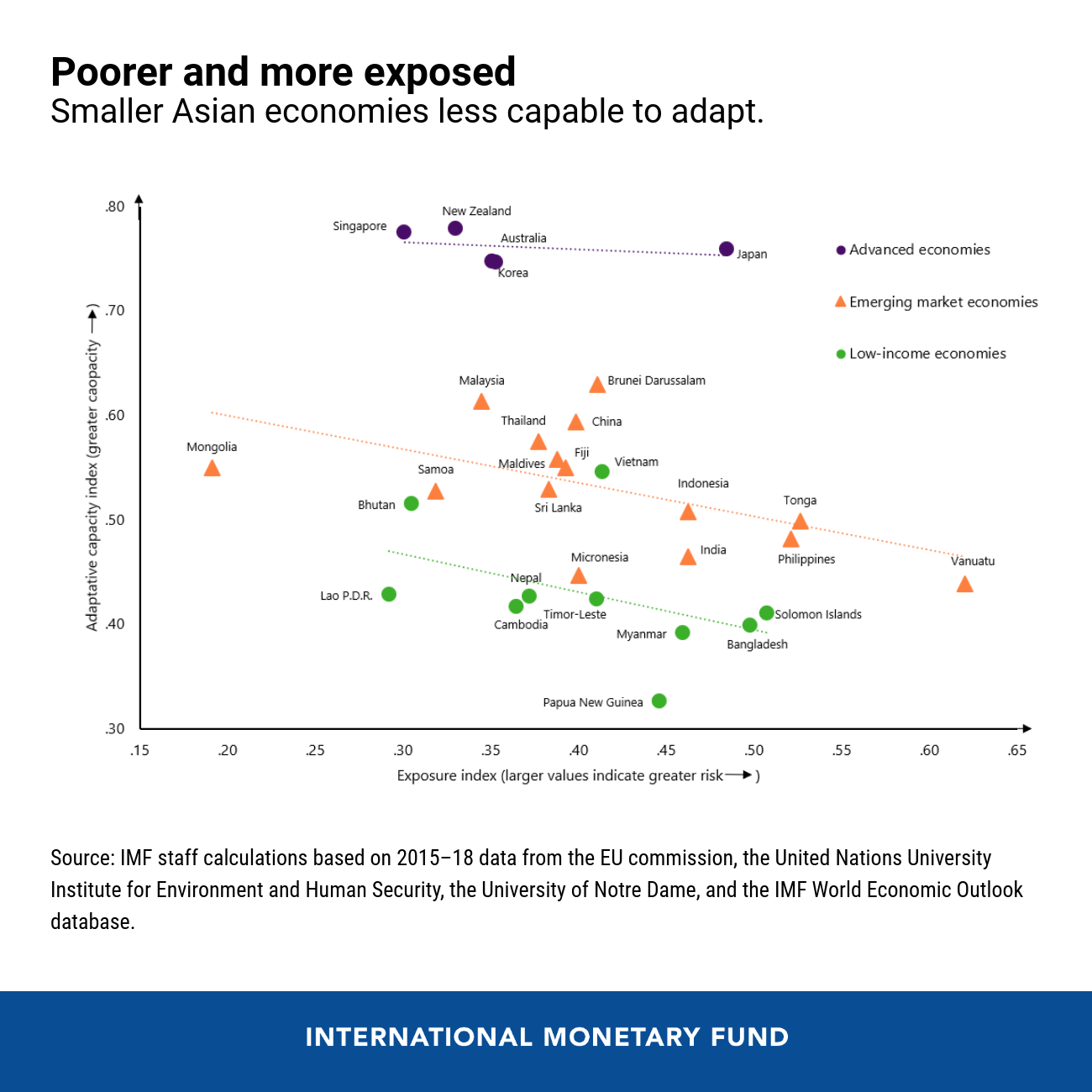Forget the poetic flap of a butterfly’s wings in Beijing causing rain in Central Park. Climate issues in Asia-Pacific are measured in superlatives. The world’s biggest population. Two of the three largest carbon dioxide-emitting countries and the largest share of emissions globally. The most exposed to extreme weather events. Some of the smallest and most vulnerable countries. Also, the fastest-growing part of the global economy and many of the leaders in green technology.
What Asia does to fight global warming will be literally felt across the whole planet.
It’s not hard to see that what Asia does to fight global warming will be literally felt across the whole planet.
Pursuing a green recovery in the aftermath of COVID-19 might sound daunting, but it’s actually a great opportunity to direct recovery spending into stimulating sustainable jobs and growth.
Green investment is generally more labor-intensive than the regular kind. The near-term extra spending and jobs would strengthen economies. In the longer-term, Asian economies would become more sustainable and resilient, and could build on their lead in many of the emerging green technologies.
What policies are needed? A newly released IMF staff paper makes recommendations in three areas.
More carbon taxes, more compensation
With the world’s most populous and fastest-growing economies, Asia-Pacific emits the largest volume of greenhouse gas, producing about half the world’s carbon dioxide. China, India (the first and third-largest emitters respectively, with the US second) and other large emitters will need to make greater efforts to reduce emissions if global warming is to be kept to the Paris Agreement’s goal of 1.5–2 degrees Centigrade above pre-industrial levels.
Taxes on the carbon dioxide released when burning fossil fuels can be a highly effective way of reducing emissions, but they are little used in the region. Even a gradually introduced and relatively modest carbon tax of $25 per ton would achieve the region’s aggregate Paris Agreement target. But Asia’s Paris targets, like other region’s, are well below what is needed and models suggest that $50-100 per ton is required globally to keep warming below 2 degrees.

Rather than taxing all emissions, much can be done by targeting the most polluting fuels. That would be very effective in countries like China, India and Mongolia, heavily reliant on coal, by far the dirtiest fossil fuel. And it comes with the added benefit of reducing air pollution, which could save some 3 million lives in China alone by 2030.
Of course, some households, workers, and firms would be particularly affected by the higher energy prices resulting from carbon taxes. They need to be identified and compensated, ideally with targeted benefits, though universal transfers can also work. For example, China could use carbon tax revenues to increase its minimum guaranteed income scheme, finance green investment or reduce other taxes.

Other policies can help. For example, more sectors can be included in emissions trading systems, in which the government sets overall limits on emissions and lets the market determine their price. Financial incentives to use less-polluting alternatives, such as electric vehicles, reduce the need to raise energy prices. Stricter regulations on air quality can support decarbonization efforts.
Increase adaptability to climate change
Even in the best of scenarios, historic emissions mean a certain amount of warming and climate change will be inevitable. Extreme weather events are only expected to intensify, so adaptation is urgent. Rising sea levels alone could directly affect a billion people by mid-century, potentially submerging many cities and wiping out entire nations.
Low-income and Pacific island countries are particularly vulnerable and need to invest in protecting infrastructure, making water resources more resilient, adapting dryland agriculture, restoring mangroves, and improving early warning systems for natural disasters.

But some of the most vulnerable have the least resources to prepare. Adaptation requires stepping up public investment, on average by about 3 percent of GDP annually. For the smallest, also the least-polluting countries, the price tag is higher. A recent IMF/World Bank assessment concluded that Tonga would have to spend $67 million a year in climate adaptation for 10 years. Doesn’t sound much, until one realizes this is 14 percent of its GDP, which underscores the need for greater international support for such countries.
Greener recovery from COVID-19
The COVID-19 crisis does not change the climate crisis, but provides an opportunity to tackle it. How? By ensuring that as much as possible of the very large recovery spending is allocated towards greener activities. Some countries are already doing that, like Korea in its Green New Deal. But much more can be done as the pandemic response shifts from crisis containment to recovery.
Countries seeking to accelerate the transition to carbon neutrality can invest in renewable energy, retrofitting buildings, upgrading the electricity grid, facilitating electric cars, and incentivizing research. When the main challenge is adaptation, they could upgrade infrastructure projects, retrofit existing assets, and develop coastal protection. For many, it will be a combination of both.
Global efforts to promote and finance the transfer of green technologies to developing countries and expanding multilateral climate funds need to be stepped up. The IMF is helping by integrating climate in our annual country economic assessments and scaling up capacity development to ensure government officials have the needed skills to handle these complex issues.
Butterflies still matter…
In a 1952 short story, American science fiction writer Ray Bradbury imagined a man from 2055 who travels to the past and, by accidentally stepping on a butterfly, changes the outcome of his day’s presidential election. It was “a small thing,” Bradbury writes, “that could upset balances and knock down a line of small dominoes and then big dominoes and then gigantic dominoes.” In our global fight against climate change, Asia-Pacific is a gigantic domino that cannot fall. As the world recovers from COVID-19, now is the time and opportunity to ensure ourselves a better 2055.






